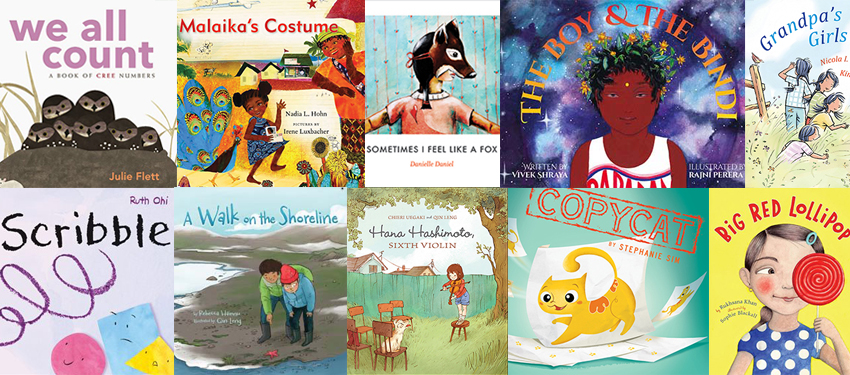I am so pleased to have been given the chance to write this post for Room about some of the talented women behind Canadian picturebooks. Most of my academic and non-academic pursuits revolve around children’s literature, but it’s not often that I get to focus on picturebooks. I took this chance to introduce you to ten truly wonderful works of art and storytelling, all as vibrant as they are entertaining.
Room’s Top 10 Picture Books by Canadian Women of Colour
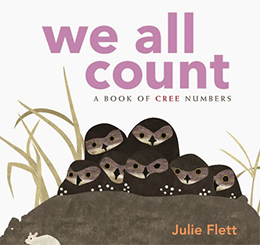
1. We All Count: A Book of Cree Number (Native Northwest, 2014) by Julie Flett.
Ever since I encountered her work at school, Flett has been one of my favourite illustrators. Her style is simple and striking—something that serves to welcome readers from a range of age groups—and her colours are minimal, but alluring. With Wild Berries, and her more recent boardbook release, We All Count, Flett has become one of my favourite authors too. In this particular book, Flett draws on her Cree-Métis heritage to create something special, a book of numbers that moves fluidly between language barriers, connects hyphenated identities, and is informational in a way that does not alienate audiences. Combined with Flett’s signature style, We All Count is a beautiful example of art and storytelling coming together in the form of a picturebook.
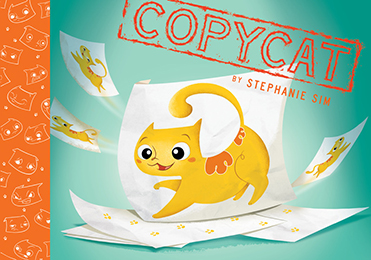
2. Copycat (Simply Read Books, 2015) by Stephanie Sim
This was a new discovery for me, and an exciting one: not only is Sim both illustrator and author of her sweet story about a printed cat that comes to life, Copycat is one of those gem-like picturebooks that works perfectly without words. Wordless picturebooks are difficult feats, though the idea behind them seems simple. There has to be a solid story that keeps us moving forward and the illustrations not only have to convey this story, they must also reflect the story’s tone, pacing, atmosphere, and do all this with ease and clarity. Copycat accomplishes all this and more. Through her adorable illustrations and clever story, Sim tells readers the story of a lonely and (literally) two-dimensional cat that wants to play with other, not-so-papery cats. The story is heart breaking and heart warming in turns, and you never quite get over the emotional roller coaster even after you’ve reached the endpapers.
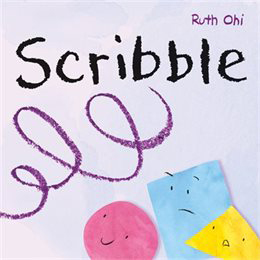
3. Scribble (Scholastic Canada, 2016) by Ruth Ohi
This is one that I’ve been itching to talk about for a good, long while. Another author/illustrator, Ohi combines her superpowers to create this unique picturebook that is sure to be a classic. The premise strays from traditional picturebooks and plays with format—what happens when a circle, a square, and a triangle, meet something unconfined and unusual? As it turns out, the answer is that unprecedented and unconventional things follow. Each shape and squiggle on its own is fine enough, but Ohi shows how much more they can accomplish when they find a way to make their differences work for them instead of against them. It’s a touching story that offers different things to different readers. Personally, I was glad to see a picturebook subtly encourages people to examine differences rather than seeking out only similarities between each other. What is marvellous is how clearly this complex message is conveyed over thirty pages and how deeply the message is felt. It’s no wonder that Ohi is described as one of the premier Canadian illustrators and authors for children.
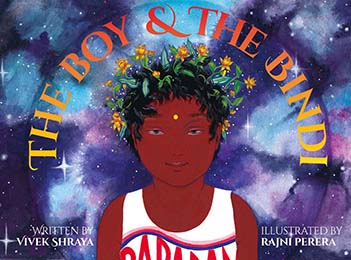
4. The Boy and the Bindi (Arsenal Pulp Press, 2016) by Vivek Shraya, illustrated by Rajni Perera.
The best thing about compiling this list for Room is that I have the opportunity to encounter stories that I have never encountered before, but with Shraya’s book it is not just about reading something new, it is about wishing you’d had this book in your hands as a child, it is knowing you’ve read something that has transformational qualities. The Boy and the Bindi follows a young boy on his journey to understanding the faith he and his mother share, what the particular tradition of wearing a bindi means, and how he understands himself by wearing a bindi. The story is accompanied by some of the most lush illustrations I’ve ever seen—especially where South Asian culture is concerned—and overall, the picturebook is sure to delight readers, young and old, Hindu or not. It is certainly a release to look out for in October.

5. Sometimes I Feel Like a Fox (House of Anansi, 2015) written and illustrated by Danielle Daniel.
This book resonated with me in much the same way that Flett’s illustrations do or Shraya’s writing does. Another rare gem of a book, Sometimes I Feel Like a Fox is one of the few picturebooks on totem animals within the Anishinaabe tradition. The book is dedicated to “all the Métis and Aboriginal children who grew up never knowing their totem animal”, so it is only fitting that each beautiful illustration features a child and their respective totem animal. The words that accompany each of these portraits describe why or how they identify with their totem animal. It is, like Scribble, an unconventional story, but it is a strong story nonetheless. Informational without being didactic, Sometimes I Feel Like a Fox is important and fun in equal measure. It is sure to engage audiences over and over because each re-read yields some new way of understanding the totem animals and the children.
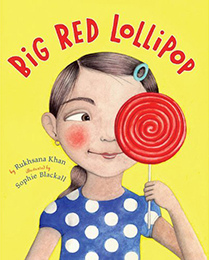
6. Big Red Lollipop (Viking Children’s Books, 2010) by Rukhsana Khan, illustrated by Sophie Blackall.
There are several things I love about Khan’s work, but I’d like to start with how good the book’s design is: from with the bright yellow cover, to the pretty lollipops on the endpapers, this is a picturebook that might as well jump off bookshelves and into readers’ arms. And the story is as striking as the cover. What I loved about Khan’s story is how it isn’t about sacrifice, or compromise, or assimilation, or any other unyielding word that is typically used to describe conflicts or transitions such as the ones described in Big Red Lollipop. Instead, it is merely a story about two sisters, the bond they share, and how this bond can be both broken as well as healed through sugary treats and sweet gestures. Blackall’s style compliments Khan’s words perfectly and the end result is a picturebook you want to re-read almost immediately, only this time alongside family members and loved ones.
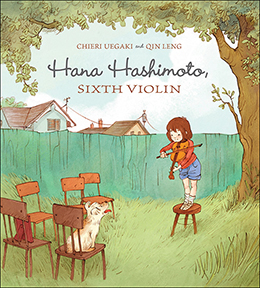
7. Hana Hashimoto, Sixth Violin (Kids Can Press, 2014) by Chieri Uegaki and illustrated by Qin Leng.
It all begins with Hana deciding to play the violin for her school’s talent show and her brothers insisting that she just isn’t good enough. But Hana is determined and each time she practices, not only does she get better, she relives her time with her grandfather, a famous violinist in Japan. His music had the power to bring feelings, memories, and even fireflies to life. Whether or not Hana is able to do the same, what I can say for sure is that Uegaki and Leng manage to evoke magic and music through just their words and pictures. Hana Hashimoto, Sixth Violin is a picturebook that makes you wish it came with music, for that is the only thing that could improve the experience of reading such a well-crafted picturebook.
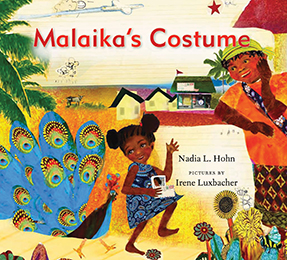
8. Malaika’s Costume (House of Anansi, 2016) by Nadia L. Hohn, illustrated by Irene Luxbacher.
Mailaika’s Costume is the moving story of a young girl, Malaika, who lives with her grandmother in an unnamed Caribbean country, while her mother looks for work in Canada. Malaika is waiting for her mother to send back some money for her Carnival costume, but when the money does not come, Malaika must seek out a way to make her dreams come true—it’s lucky that she doesn’t have to do this on her own. Hohn explores difficult issues with a deft hand and touching topics with warm words, the style of the narrative and the dialogue is colloquial, the voice is authentic, there’s even a helpful glossary at the beginning, and the collage-style illustrations make the words feel that much more tactile and real. I wouldn’t mind having a whole series dedicated to Malaika.

9. Grandpa’s Girls (Groundwood Books, 2011) by Naomi I. Campbell, illustrated by Kim LaFave.
I’d first encountered Campbell’s work by accident, when I found a signed copy of Shi-shi-etko for sale at a bookstore, while seeking out First Nations picturebooks. It was, of course, a happy accident. And I am equally happy now to talk about Campbell’s more recent work, Grandpa’s Girls. The title gives away the premise, but what is interesting about the story is that it focuses on the grandfather as much as it does on the girls. The grandfather, Interior Salish like Campbell herself, contains multitudes, so for his visiting granddaughters, it’s not only a chance to experience life on a farm, but to explore his past—and by extension their own backgrounds—and learn more about themselves. Grandpa’s Girls contains more text than any of my previous picks, but I doubt that will deter younger readers who tend to read a level up. The illustration style works well with Campbell’s words and together they create something pretty special.
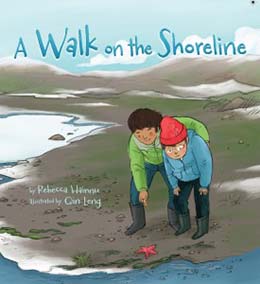
10. A Walk on the Shoreline (Inhabit Media, 2015) by Rebecca Hainnu, illustrated by Qin Leng.
Slightly longer and text-heavier than the other books on my list, A Walk on the Shoreline is somewhere between a picturebook and a storybook, and also somewhere between fiction and non-fiction. Set in Nunavet, where Hainnu is from, the book follows Nukappia who is visiting with his biological family and learning how they coexist with their environment. Each item that he finds along the shoreline holds some kind of importance, be it cultural or medicinal. As Nukappia learns, so do we, and Leng’s illustrations double the joy of discovering things that Nukappia discovers or meeting the people that Nukappia meets. At the end, we even get a glossary, complete with photographs, pronunciations, and traditional uses. A Walk on the Shoreline is special, not just because of its content, but also because as (partly) non-fiction it has a much wider reach than some of the other books on my list.
